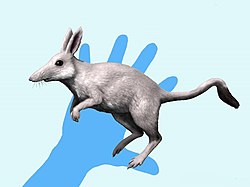| Nanocuris Temporal range: Late Cretaceous (Maastrichtian) | |
|---|---|
| Scientific classification | |
| Domain: | Eukaryota |
| Kingdom: | Animalia |
| Phylum: | Chordata |
| Class: | Mammalia |
| Order: | † Deltatheroida |
| Family: | † Deltatheridiidae |
| Genus: | † Nanocuris Fox, Scott & Bryant, 2007 |
| Species: | †N. improvida |
| Binomial name | |
| †Nanocuris improvida Fox, Scott & Bryant, 2007 | |
Nanocuris is an extinct genus of Deltatheridiidae from the Cretaceous of Canada (Saskatchewan) and United States (Wyoming - Lance Formation and Hell Creek Formation [1] ). [2] Initially, it was classified in a proper family, Nanocuridae, in the clade Eutheria, [2] but a reanalysis of a new specimen revealed a delthatheroid affinity of the genus. [3]





